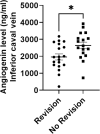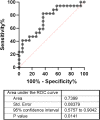Role of circulating angiogenin levels in portal hypertension and TIPS
- PMID: 34432848
- PMCID: PMC8386873
- DOI: 10.1371/journal.pone.0256473
Role of circulating angiogenin levels in portal hypertension and TIPS
Abstract
Background: Pathogenesis of portal hypertension is multifactorial and includes pathologic intrahepatic angiogenesis, whereby TIPS insertion is an effective therapy of portal hypertension associated complications. While angiogenin is a potent contributor to angiogenesis in general, little is known about its impact on TIPS function over time.
Methods: In a total of 118 samples from 47 patients, angiogenin concentrations were measured in portal and inferior caval vein plasma at TIPS insertion (each blood compartment n = 23) or angiographic intervention after TIPS (each blood compartment n = 36) and its relationship with patient outcome was investigated.
Results: Angiogenin levels in the inferior caval vein were significantly higher compared to the portal vein (P = 0.048). Ten to 14 days after TIPS, inferior caval vein angiogenin level correlated inversely with the portal systemic pressure gradient (P<0.001), measured invasively during control angiography. Moreover, patients with TIPS revision during this angiography, showed significantly lower angiogenin level in the inferior caval vein compared to patients without TIPS dysfunction (P = 0.01).
Conclusion: In cirrhosis patients with complications of severe portal hypertension, circulating levels of angiogenin are derived from the injured liver. Moreover, angiogenin levels in the inferior caval vein after TIPS may predict TIPS dysfunction.
Conflict of interest statement
The authors have declared that no competing interests exist.
Figures





References
Publication types
MeSH terms
Substances
LinkOut - more resources
Full Text Sources

